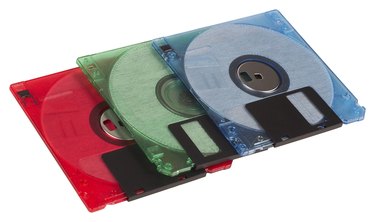
In the not-so-distant past, floppy disks were the standard method for storing electronic information. Very few PCs still use floppy disk drives today, but it is possible to add a floppy disk drive to your computer if required. Many motherboards still offer an FDD connector although the drives themselves are harder to find.
What Is the FDD Connector?
Video of the Day
FDD stands for floppy disk drive. Although most computers no longer use floppy drives, the FDD connector is still present on many motherboards. The FDD connector contains 34-pins, and uses a FDD ribbon cable to connect to a 3 ½" floppy disk drive. Identify this cable by the twist between the first and second set of connectors, which allocates the drive at the end of the cable as FDD A, and the drive in the middle as FDD B.
Video of the Day
The 3½” Floppy Disk Drive
During the 1990s, every PC had a 3½" Floppy drive, which was the main method of transferring data to or from the computer. The floppy drive used disks enclosed in a rigid plastic case for protection, available as either double density storing 720-Kb of data, or high density storing 1.44Mb. These were a big improvement over previous 5¼" disks, which were housed in a cardboard envelope and were truly floppy, hence the name.
Why Doesn't My Computer Have A Floppy Disk Drive?
As applications became larger, it took more and more floppy disks to install them, with large packages requiring over 20 disks and taking over an hour to install. As multimedia content grew more popular, sound and video required larger files, which were often too large to fit on a floppy disk. These problems fired the way forward for CDROM drives, which could store over 600Mb, and became the format of choice for multimedia and program installations. This solved half the problem, as users could read but now write large files. With the advent of CD Burners, users were able to write their own disks, and as the CD took over floppy disks were phased out. With the introduction of USB, flash drives became popular for their large storage capacities and fast access times, and computer manufacturers stopped including a floppy drive as standard.
Adding A Floppy Disk Drive
Installing a 3½" disk drive is simple, and uses only two connections. First, connect the data cable that runs between the drive and the FDD connector on the motherboard, and then plug in a free power connector from the power supply into the drive. You then need to go into the computer's BIOS settings and enable the drive. One problem you may have is that floppy disk drives are relatively hard to get hold off, and only a small number of vendors now stock these drives. One simple solution is to purchase a USB external floppy drive, which is available at low cost and plugs into a free USB port. These are readily available, and are easier to install, as you do not have to open your computer.
- Simulation Exams: Storage Devices, and Interfaces
- Hardware Secrets; How to Install a Floppy Disk Drive; Gabriel Torres; November 2007
- Null Modem: Floppy Drive Connector
- Citizen: 3.5" Micro Floppy Drive Specification; [PDF]
- Build Easy PC: How To Install a Floppy Disk Drive
- Accurite: Floppy Disk Drive Primer